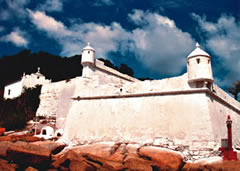|
Santo
Amaro da Barra Grande Fortress achieved its peak of glory in
the 18th century on account of the gold found further inland, the
progress of São Paulo Captaincy and, finally, the instability
of the Platinum Region border. The irregular design of its current
structure, spreading along the natural lay of the land, follows
the restoration project carried out by Military Engineer João
Massé, sent by the Portuguese Crown in 1714. Portuguese Brigadier
José da Silva Paes continued Massé's project and transformed
the Gun Powder House into a chapel dedicated to Patron Saint Amaro
in 1742. He also built a new store-house with thick double walls
on top of the rocks to keep the gun powder temperature and humidity
in adequate condition. The crossfire fort - Castro or Estacada -
situated within the border area, currently where the Fishing Museum
of Santos is built, also belongs to Engineer João Massé.
|
 Eraldo Silva/UNISANTOS |
 Estado Actual dos diversos desmeritos da Fortaleza da Barra Grande, séc XIX, Arquivo Histórico do Exército, RJ |
|
|